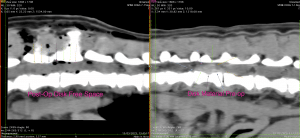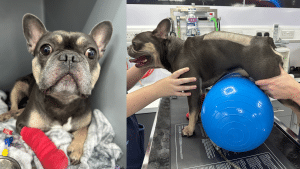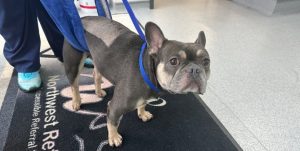With the consent of Speedo Mick, in order to raise awareness for this critical disease we are able to share a timeline of events taking us through the ups and downs of dealing with this disease that is sadly becoming very common amongst the bully breeds. It is important to act fast if you notice any symptoms and this timeline should hopefully answer a lot of questions that you may have.
12th March 2023
I received a text message from one of my referring veterinary surgeons based in Liverpool that Speedo Mick had posted on Facebook that his dog Blue had lost the use of his back legs and that he needed help. We reached out to Mick who was on the train back from London to Liverpool to assess Blue. I told him that we could see them the following morning at 9:30am. Based on the symptoms at this stage, the prognosis was likely to be IVDD and sounded like a grade 3-4 however a full clinical examination would determine this. IVDD is graded from 1-5, 5 being the most severe.
13th March 2023
Mick and Blue attended the appointment for clinical examination. At this point Blue had lost the use of his hind legs, had no control of his bladder but had deep pain. This meant that although he could not use his legs, there was some sensation in them on examination. This would grade Blue as 4/5 in severity and increase the odds of Blue walking again. In most cases an MRI scan would be the preferred modality for spinal disease, however, after a discussion with Mick we opted for CT. Unlike MRI, the CT scan will NOT show the spinal chord itself, however it will show the disc material in the vertebral canal that is the cause for the paralysis.
The CT scan process takes around 20 minutes from inducing the patient. The results showed disc material present at the disc space T13-L2; very common in the French bulldog breed. This disc material had extruded the vertebrae and was compressing the spinal chord causing paralysis and loss of bladder control. The longer the compression on the spinal chord the worse the prognosis would be for Blue. Full loss of sensation causes the nerves to die, meaning there was a chance that Blue would not walk again. In most cases, surgery done within 48 hours of symptoms starting has a positive prognosis.
It was at this point, knowing how much Mick had done for the wider community and mental health charities, raising almost 1 Million pounds for charities, it was about time that someone did something for him. So, we did the procedure free of charge.
Our neurosurgeon performed a Hemilaminectomy between the T13-L3 disc space. A post op CT scan confirmed that all the extruded disc had been removed and therefore decompressed the spinal chord. Over the next few days we would expect to see the symptoms of Blue improving with pain relief, physio therapy and rest.
14th March
1 day after surgery. Blue was very comfortable and had a great night sleep ready to start his recovery process. We incorporated very light physio into his care plan. This included range of motion movements that simulate normal his anatomical advances. This includes massaging the legs to increase blood flow, moving the legs slowly to stop any cramping and the use of slings/physio balls to aid him standing. In addition to this, Blue had some very strong IV pain relief and antibiotics and had a urinary catheter in situ until the use of his bladder had improved.
15th March
Although Blue was missing home he continued physio and his battle to get better. As improvements were made, we moved Blue onto oral pain relief and removed his catheter to see what his bladder function was. With patients like Blue use a sling underneath the abdomen to hoist them up gently and encourage the patients to walk. We have a designated toilet area with both paving and grass for patients to toilet. Blue is not able to urinate on his own.
16th March
Speedo Mick has an appointment at 3:30pm to pick Blue up just 3 days after surgery. A full discharge appointment was booked with the neurosurgeon so that Mick could ask any questions he had. We gave full instructions verbally with paper handouts to read at home. Post-operative instructions include strict cage rest for the first 4 weeks and continued physio therapy at home. We have managed to source some hydrotherapy sessions at Smarter Pets Hydrotherapy Centre in Maghull. However, these more intense sessions will be held once Blue is recovered more.
17th March
We made a courtesy call to ensure that Blue is settling well, comfortable, pain free and happy. An appointment was made for 1 week in clinic to recheck his condition. At this point the aftercare is managed by the owner. Including crate rest and minor physio for the next 4 weeks.
22nd March
Blue is progressing and has now regained the use of his bladder. We encouraged blue to go out to toilet on a lead and used a sling to support his back. Blue was trying to stand and could stand with the help of Mick. On this visit we can see his symptoms improving.
4th April
Blue came back to see us and can now walk fully unaided although still a little wobbly. Blue still needs to rest and recover he has made great progress with his condition. We will see him again in 3 weeks time to reassess.
26th April
Blue came to visit us. He is doing great and is fully walking again. The continued care plan now is hydrotherapy and 5-minute lead walks for the next 4 weeks. After this, lead walks will gradually increase but he will be fully signed off to enjoy the rest of his life. This is just in time for Speedo mick to finally hang up his boots and retire after 7 amazing years of fund raising a massive 1 Million pounds for charity.
24th May
Blue is finally signed off and is free to chase the pigeons again and enjoy the rest of his days with his newly retired owner Speedo Mick. This is a very typical recovery for a grade 4 IVDD but diagnosing this earlier can help with a quicker recovery.
If you have a pet that you think maybe is starting to suffer from IVDD then please contact us for advice on:
Tel: 01942 242001 or send us an email at
info@northwestreferrals.co.uk.







